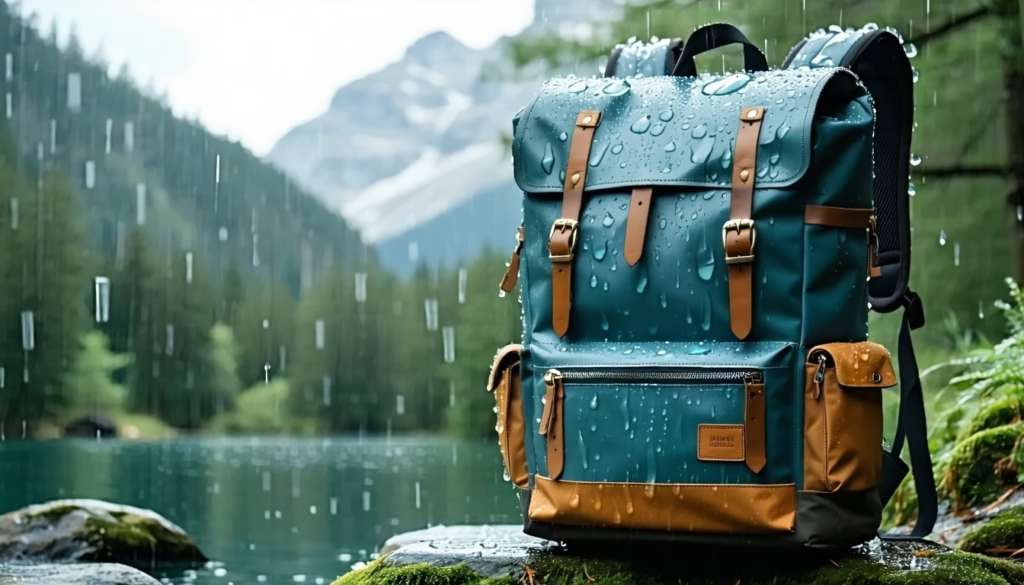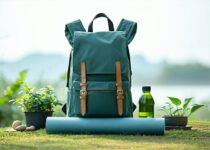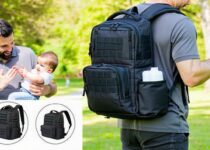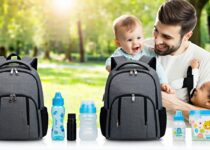Weather-Resistant Materials For A True All-Season Weekender Bag

Ever gotten caught in a downpour mid-trip and ended up with damp gear?
We’ve been there.
In this guide, we’ll break down the top weatherproof materials and show you how to pick a weather-resistant weekender backpack that stands up to every season.
Weatherproof Fabric Options
Picking the right fabric is step one. You want a material that holds up against rain, sleet, dust, and sun without weighing you down. The ideal choice feels smooth against the skin, while shrugging off moisture and debris.
Waxed Canvas Advantages
Waxed canvas dates back to the 19th-century outdoor gear. It’s cotton canvas treated with wax to shed water and resist tears. Waxed canvas ages beautifully, gaining a rugged patina that tells your travel story.
- Natural look that patinas with use
- Strong and abrasion-resistant
- Can be waterproofed with rewaxing
- Heavier than synthetic options
Synthetic Material Strengths
Modern synthetics like nylon and polyester bring big perks. They’re lightweight, quick-drying, and often come with factory-applied weatherproof finishes. You’ll often find multiple denier ratings to balance strength and packability.
- Exceptional water shedding with DWR treatments on robust nylons like those in a nylon weekender backpack
- High tensile strength to resist tears
- Easy to clean with a damp cloth
- Available in ripstop variants for extra toughness
Water-Resistant Finish Types
Besides fabric choice, finishes play a big role. They add minimal weight but can dramatically boost performance under adverse conditions. These coatings help beads of water roll right off.
Durable Water Repellent Coatings
DWR (durable water repellent) is a standard finish at the mill. It adds a micro-thin layer that sits on the fabric surface. Over time, it wears off, so you might need to reapply.
- Pros: lightweight, preserves breathability, retains performance under light rain
- Cons: needs periodic retreatment, may trap odors over time
Laminated Membranes Explained
Laminated membranes sandwich a waterproof film between outer and inner fabric layers. Think of them as a raincoat built into your bag. They block water completely but can add stiffness.
- Pros: full waterproof barrier, reliable under heavy downpours
- Cons: may reduce ventilation, membrane can delaminate if exposed to heat
If you need a fully sealed interior, consider a waterproof weekender backpack with welded seams.
Comparing Material Performance
Different materials bring different tradeoffs. We ran a quick table to weigh durability, water resistance, and weight. Each trip has unique demands, so this snapshot helps you see which fabric ticks your boxes.
| Material | Water Resistance | Durability | Weight |
|---|---|---|---|
| Nylon | High | High | Light |
| Polyester | Medium | Medium | Light |
| Canvas* | Low | High | Heavy |
*Canvas can be treated for better water resistance.
Nylon Vs Polyester
Nylon usually outperforms polyester in strength and abrasion resistance. Polyester resists UV damage better and can be more colorfast. Both dry quickly and are easy to clean. Price points vary, too—nylon often costs more, while polyester stays budget-friendly.
Canvas Vs Leather Vs Nylon
Leather adds style and durability, but soaks up water if untreated. Canvas delivers classic outdoor vibes and toughness, but needs rewaxing. Nylon hits a sweet spot for lightweight and weatherproofing. For a deeper dive into fabric pros and cons, check our canvas vs leather vs nylon backpack guide.
Integrating Functional Features
Material is only half the story. You can have top-notch fabric, but bad zippers or thin buckles will leave you out in the rain. Hardware, seams, and fasteners need to pull their weight too.
Sealed Seams And Zippers
Heat-welded or taped seams keep water out at vulnerable points. Look for water-resistant YKK zippers that bite tight under pressure. A flap or storm guard over the zipper adds an extra barrier. Always test hardware under load before hitting the road.
- Taped seams block water entry
- Flap-over zippers deflect rain
- Seam tape quality matters—look for waterproof-rated tapes
- Rubberized pulls resist slippage
Reinforced Hardware Tips
Buckles and webbing should be sturdy enough to handle repeated loading and rough use. Metal D-rings and coated hook releases age better than cheap plastic. Reinforced base panels prevent wear if you set your bag on rocky ground.
- Metal or heavy-duty polymer buckles
- Thick webbing at stress points
- Quick-release buckles for fast access in a downpour
- Rubberized feet or panels on the bottom
For more on must-have features, see our weekender backpack features page.
Caring For Your Backpack
Keeping your bag in top shape ensures those weatherproof properties stick around. Trust us, a little elbow grease can extend a bag’s lifespan by years. A little care goes a long way.
Cleaning Weatherproof Fabrics
Most treated fabrics clean up with a damp cloth and mild soap. Avoid harsh detergents or bleach—they can strip finishes. Deep cleans are rare—spot treatment keeps that protective finish intact.
- Spot-clean stains quickly
- Use non-detergent soap
- Avoid fabric softeners; they can leave residues that attract dirt
- Air dry—no machine
For a step-by-step routine, check our cleaning weekender backpack guide.
Reapplying Protective Coatings
When water stops beading, it’s time for a refresh. Spray-on DWR treatments are easy to apply at home. Wax bars work for canvas—just heat or rub in, then buff off excess.
- Follow product instructions
- Treat in a well-ventilated area
- Warm wax blends melt evenly for a consistent finish
- Let it cure fully before use
You can use a hairdryer on canvas wax to help it bond.
Packing For All Seasons
Stuck on how to pack for the shifting weather? We’ve got you covered. A solid system keeps you nimble when the forecast changes on the fly.
Using Packing Cubes
Packing cubes help you organize layers and swap gear quickly. We like to reserve one cube for rain gear—jacket, pouch, and small tarp. We even pack a small towel cube for unexpected puddles.
- Keep wet items separate
- Use color-coded cubes for quick gear grabs
Read more about organizing tips in our packing cubes in the backpack piece.
Protecting Electronics
Electronic gear loves a dry pocket. Choose a padded, weatherproof compartment or slip items into sealed pouches. Some bags feature roll-top pockets that seal out moisture completely.
- Use a ziplock or a dry bag for extra security
- Store power banks in the external pocket
- Waterproof pouches double as floatation for small devices
Check bag specs for integrated tech pockets in our tech in weekender backpack guide.
Eco-Friendly Material Choices
Want to tread lightly while chasing your next adventure? Eco picks won’t let you down on performance, but double-check data to avoid greenwashing. Eco materials blend performance with planet-friendly manufacturing.
Recycled Fabric Options
Recycled nylon and polyester keep plastic out of landfills. Many leading brands now offer packs made from ocean plastics. Recycled blends can even outperform originals in certain denier ratings.
- Look for GRS or Bluesign certifications
- Brands often list plastic sources on tags for transparency
For more sustainable picks, see our eco-friendly weekender backpack roundup.
Biodegradable Coatings
New DWR formulas boast biodegradable chemistries. They break down into safe compounds over time. The tech landscape is evolving fast, so check for updates each season.
- Check product specs for bio DWR labels
- Bio-based DWRs may need annual retreatment compared to standard coatings
Avoiding Common Pitfalls
Even top materials can fail if you overlook fit or upkeep. These fixes prevent small problems from turning into epic packing day fails. Let’s cover a few common slip-ups.
Ignoring Strap And Fit
A weatherproof shell won’t help if your straps dig in or the bag flops while you walk. Test load distribution and adjust harness systems before long trips. A quick test with 20 pounds loaded shows if your straps will cut in.
- Use a sternum strap backpack for balance and stability
- Check hip belt adjustability to transfer weight off shoulders
- Adjust shoulder straps to sit high on the back
Skipping Routine Maintenance
You’ll pay later if you let small tears or worn coatings linger. Inspect your bag monthly, patch rips immediately, and re-treat finishes when needed. Regular checkups keep you from learning about a leak the hard way.
- Store your bag in a cool, dry place to protect fabrics
- Patch small tears right away to prevent spreading
Frequently Asked Questions
What Is A Weatherproof Fabric?
Weatherproof fabric refers to materials treated or constructed to block rain, wind, and sometimes dust. It can include coated synthetics, waxed canvas, or laminated membranes.
How Often Should I Reapply DWR Coating?
Plan to recoat your bag every 6 to 12 months, depending on use. When water stops beading on the surface, it’s a good sign to refresh your finish.
Can I Machine Wash My Weekender Bag?
We don’t recommend machine washing. Instead, spot clean treated fabrics with mild soap and water to preserve protective finishes.
Does Weatherproof Mean Waterproof?
Not always. Weatherproof often means resistant to moisture and light rain. Waterproof implies a full seal against heavy downpours or immersion.
Is Waxed Canvas Better Than Nylon?
It depends on your priorities. Waxed canvas offers durability and a unique patina, while nylon is lighter and easier to maintain.
Are Recycled Materials Durable?
Modern recycled fabrics match the strength of virgin materials. Certifications like GRS and Bluesign help verify quality and eco credentials.
Can I Use Wax On Other Fabrics?
Wax bars work best on natural fibers like canvas or cotton duck. Attempting to wax synthetics can lead to uneven coverage and fabric breakdown.
By choosing the right weatherproof materials and caring for your weekender bag, you’ll stay dry and organized no matter the forecast. From waxed canvas to recycled nylon, there’s a fabric to fit your style and needs.
Give one of these options a try on your next trip and see how it handles a little rain or snow. Drop a comment to let us know which material keeps your gear safest, and share this guide with your fellow travelers.


